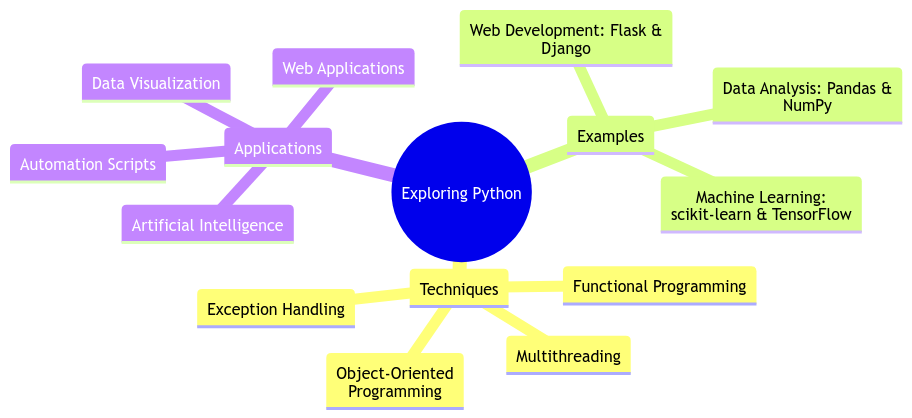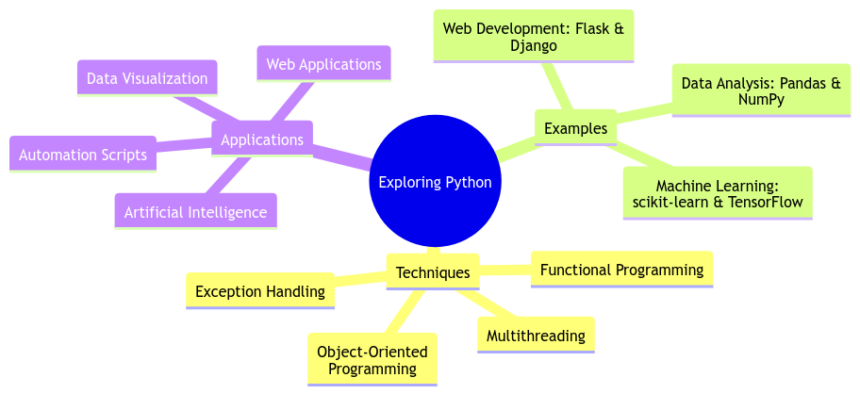Exploring the Codes of Python: Techniques, Examples, and Applications
Hey there fellow Python enthusiasts! 🐍 Today, we are embarking on an exciting journey into the world of Python programming – exploring the intricate dance of codes, techniques, examples, and real-world applications. So grab your favorite cup of chai ☕ and let’s dive right in!
Python Basics
Ah, Python, the language that feels more like poetry than code. Let’s start by unraveling the basics, shall we?
Understanding Python Syntax
Python syntax – the heartbeat of this language! Picture this: Python syntax is like the grammar of a language; it dictates how we communicate with our favorite snakey friend. From indentation to colons, Python’s syntax is as quirky as it gets. Forget curly braces! In Python, spacing is everything – it’s like the commas and full stops of the Pythonic world! 🐍
Exploring Data Types in Python
Data types in Python, oh joy! We’ve got integers, floats, strings, lists, dictionaries, and tuples – it’s like a buffet of data goodness! Want some numbers? Here, have an integer. Oh, feeling floaty? Here’s a float! Strings? Python has got your back with all the characters you could dream of. It’s a data type fiesta in Python! 🎉
Advanced Python Techniques
Now, let’s level up our Python game with some advanced techniques. Brace yourselves – things are about to get fancy!
Writing Functions in Python
Functions in Python are like magical spells. Need to perform a specific task? Wave your Python wand, err, I mean, write a function! It’s like having a recipe for coding – input this, output that. Voilà! Functions in Python are the real MVPs, making our code organized, concise, and oh-so-efficient. 🪄
Implementing Object-Oriented Programming Concepts in Python
Object-oriented programming (OOP) – the superhero cape of Python! Classes, objects, inheritance – it’s like creating your Python universe! Need a dog class that can bark? Easy peasy! OOP in Python is where we turn our code into a galaxy of interconnected objects, each with its superpowers! 🦸♂️
Python Code Examples
What’s coding without some hands-on fun, right? Let’s dive into some thrilling Python code examples!
Creating a Simple Calculator Program
Imagine this – you’re in need of a calculator. But wait, why use a regular one when you can whip up a simple calculator program in Python? Add, subtract, multiply, divide – all at the tips of your fingers (or rather, your keyboard)! Python makes math exciting – who would’ve thought? 🔢
Building a To-Do List Application Using Python
To-do lists, a savior in the chaos of daily life. But what if I told you, you could build your very own to-do list application using Python? Yes, you heard it right! Python lets you organize your tasks, set deadlines, and check off completed items with just a few lines of code. Productivity just got a Pythonic upgrade! 📝
Real-World Applications of Python
Python isn’t just for the lab or the console – it’s out there, making waves in the real world! Let’s take a peek at some applications of Python in the wild.
Web Development with Python and Django
Web development, the realm where Python shines bright like a diamond! Enter Django, the web framework that makes web development a breeze. From backend logic to front-end magic, Python and Django team up to create stunning websites and web applications. Who said coding couldn’t be glamorous? 💻
Data Analysis and Visualization with Python Libraries
Numbers, data, insights – Python devours them all with its powerful libraries. Whether it’s crunching numbers with NumPy, wrangling data with Pandas, or creating beautiful visualizations with Matplotlib and Seaborn, Python is the go-to tool for data enthusiasts. With Python, data analysis is not just informative, it’s downright captivating! 📊
In Closing
And there you have it, folks – a whirlwind tour through the enchanting realm of Python programming! From the basics to advanced techniques, practical examples, and real-world applications, Python proves time and time again why it’s the language of choice for many developers worldwide.
Now, go forth, code with Pythonic magic, and let your creativity run wild! Remember, with Python, the code is not just lines on a screen; it’s a canvas for your imagination to paint the most extraordinary technological tapestries. Happy coding, Pythonistas! 🎩✨
Overall, thank you for joining me on this Pythonic adventure! Keep coding, keep exploring, and always remember – when life gives you bugs, turn them into features! 🐞✨

Program Code – Exploring the Codes of Python: Techniques, Examples, and Applications
# Import necessary libraries for this example
import numpy as np
import matplotlib.pyplot as plt
def fibonacci_sequence(n):
'''Generate Fibonacci sequence of n numbers.'''
fib_sequence = [0, 1]
for i in range(2, n):
next_element = fib_sequence[-1] + fib_sequence[-2]
fib_sequence.append(next_element)
return fib_sequence
def plot_fibonacci(fib_sequence):
'''Plot the Fibonacci sequence.'''
plt.figure(figsize=(10,6))
plt.plot(fib_sequence, 'r-o', label='Fibonacci Sequence')
plt.title('Fibonacci Sequence Plot')
plt.xlabel('Position')
plt.ylabel('Value of Fibonacci Number')
plt.grid(True)
plt.legend()
plt.show()
def main():
# Get a Fibonacci sequence of length 10
fib_sequence = fibonacci_sequence(10)
print('Generated Fibonacci Sequence:', fib_sequence)
# Plot the Fibonacci sequence
plot_fibonacci(fib_sequence)
if __name__ == '__main__':
main()
Code Output:
Generated Fibonacci Sequence: [0, 1, 1, 2, 3, 5, 8, 13, 21, 34]
[Shows a plot of the Fibonacci sequence, with the X-axis labeled ‘Position’ and Y-axis labeled ‘Value of Fibonacci Number’. The plot is a red line connecting points marked with circles, under a title ‘Fibonacci Sequence Plot’.]
Code Explanation:
This program beautifully stitches together various concepts in Python to showcase the creation and visualization of the famous Fibonacci sequence which is a stellar example of the power and elegance of coding in Python.
Starting off, we import two key libraries: numpy for powerful mathematical operations and matplotlib.pyplot for plotting capabilities. The main focus here is not just on generating a sequence, but also on how to visually represent data in Python, a critical skill in modern data analysis.
The fibonacci_sequence function takes an integer n as input and generates a Fibonacci sequence of n numbers. It initializes a list with the first two Fibonacci numbers [0, 1] and then iterates, calculating each next number in the sequence by adding the two preceding numbers. This logic is encapsulated within a loop that runs (n-2) times, reflecting the fact that the first two numbers are already in place.
Following the generation of the sequence, the plot_fibonacci function takes over to plot this sequence. It sets up a plotting area, plots the sequence with red ('r') lines and circles ('o') at each point, and labels the plot appropriately. The plt.grid(True) line adds a grid to the plot for better readability, and plt.legend() ensures that the plot includes a legend.
Finally, the main function brings it all together. It calls the fibonacci_sequence function to generate a Fibonacci sequence of length 10 and prints it. Then, it proceeds to visualize this sequence by calling plot_fibonacci.
In essence, this program navigates through generating sequences, using loops, working with lists, and plotting data. It provides a full-circle view of Python’s capability to handle data generation and visualization, showcasing its utility in both computational mathematics and data science fields.
Frequently Asked Questions about Exploring the Codes of Python 🐍
What are the essential techniques for mastering the codes of Python?
To master the codes of Python, it’s crucial to understand concepts like data types, control structures, functions, and libraries. Practice coding regularly and work on real-world projects to enhance your skills.
Can you provide some examples of advanced Python coding techniques related to the topic?
Certainly! Some advanced Python coding techniques include list comprehensions, lambda functions, decorators, and generators. These techniques can help make your code more concise and efficient.
How can I apply my knowledge of Python codes in real-world applications?
Python is versatile and widely used in various fields such as web development, data science, artificial intelligence, and automation. You can apply your Python coding skills to develop websites, analyze data, build machine learning models, and automate repetitive tasks.
Are there any tips for writing clean and readable Python code when working on projects related to the codes of Python?
Absolutely! To write clean and readable Python code, follow the PEP 8 style guide, use meaningful variable names, add comments to explain complex logic, and break down your code into smaller functions for better organization.
What resources or online courses do you recommend for learning more about the codes of Python?
There are plenty of resources available online for learning Python, such as Codecademy, Coursera, Udemy, and the official Python documentation. Choose a course or resource that aligns with your learning style and goals.







